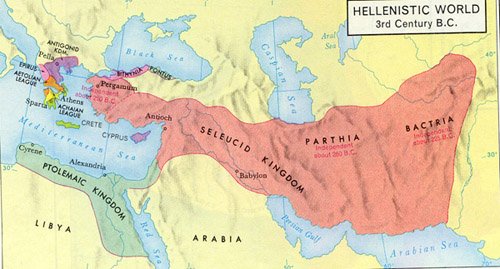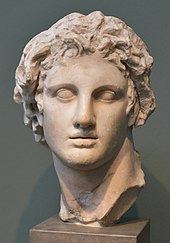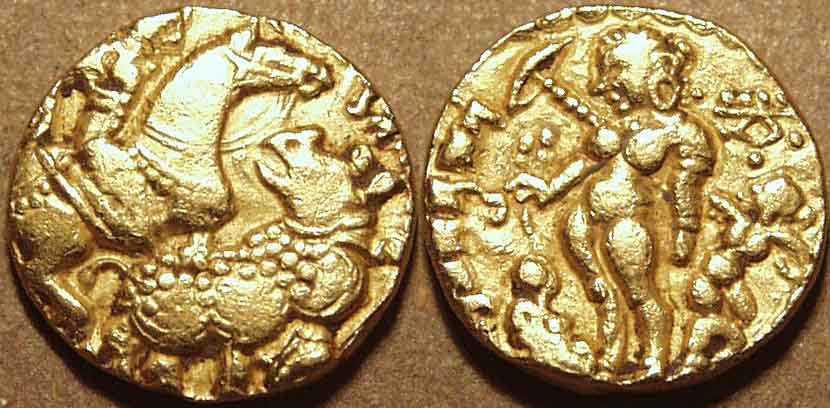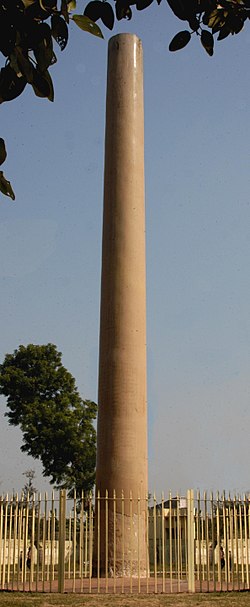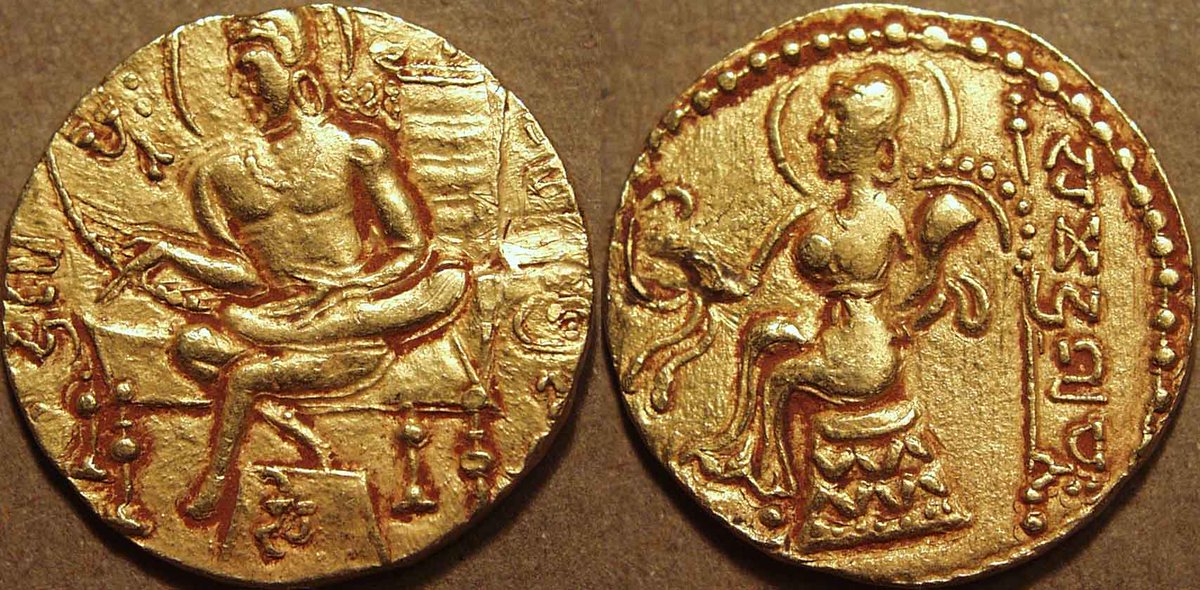
The Nanda Dynasty ( 387/382/365/345 - 322 BCE)
The Nandas were a dynasty of ancient Magadha, which created a large empire from Beas river to Odhisa.
They were exceedingly rich, powerful and perhaps the first Shudra dynasty of India.
The Nandas were a dynasty of ancient Magadha, which created a large empire from Beas river to Odhisa.
They were exceedingly rich, powerful and perhaps the first Shudra dynasty of India.

Dates:
1) Vishnu Puran gives a date of 40 years of Nandas reign;
2) Matasya Purana gives 88 years ;
3) Tāranātha gives 29 years to Nanda dynasty.
Historians have given the dates which ranges from 387 BCE to 345 BCE.
1) Vishnu Puran gives a date of 40 years of Nandas reign;
2) Matasya Purana gives 88 years ;
3) Tāranātha gives 29 years to Nanda dynasty.
Historians have given the dates which ranges from 387 BCE to 345 BCE.
Origins of Nandas : Buddhist Sources
Urgrasena Nanda or Mahapadma Nanda :-
The pali texts on the origin of Nandas present a glimpse on the origin of Nandas. His early life was quite romantic. Originally, he was from frontiers ( pachhanta-vasika).
Urgrasena Nanda or Mahapadma Nanda :-
The pali texts on the origin of Nandas present a glimpse on the origin of Nandas. His early life was quite romantic. Originally, he was from frontiers ( pachhanta-vasika).

He fell into hands of robbers who carried him captive and won him over to doctrine that pillage was preferable to tillage as pursuit.
He enlisted himself as one of gangs of robbers together with his kinsmen and soon, became their leader.
He enlisted himself as one of gangs of robbers together with his kinsmen and soon, became their leader.
Their gang started raiding the kingdoms of neighbourhood , & marching against the cities of frontiers, gave them the ultimatum, 'either surrender ur kingdom or give battle' ( rajyam va dentu yuddham va )
Gradually, they aimed at supreme sovereignty.
A robber king, thus rose to be a 'Maharajadhiraja' ( King of Kings) of Magadha, with its capital at Pātliputra ( modern day Patna, Bihar).
A robber king, thus rose to be a 'Maharajadhiraja' ( King of Kings) of Magadha, with its capital at Pātliputra ( modern day Patna, Bihar).
The Buddhist text also call Nandas ' Chorapubas' - dacoits of the old, and are not too fond of their kingship.
Jain Texts:
The Jain tradition, as recorded in the 'Parishishta-parvan' states that the first Nanda king was the son of a barber.
According to the text, the mother of the first Nanda king was a courtesan.
The Jain tradition, as recorded in the 'Parishishta-parvan' states that the first Nanda king was the son of a barber.
According to the text, the mother of the first Nanda king was a courtesan.
Evidence From Puranas:
The Puranas name the dynasty's founder as Māhāpadma, and claim that he was the son of the last Saisunaga king, Mahanandin.
The Puranas also state that Māhāpadma's mother was a Sudra.
The Puranas name the dynasty's founder as Māhāpadma, and claim that he was the son of the last Saisunaga king, Mahanandin.
The Puranas also state that Māhāpadma's mother was a Sudra.
Greek Evidence:
Q. Curtis Rufus states that:
The father of Agrammes was a barber scarcely staving of hunger by his daily earnings, but who, from his being not uncomely in person, had gained affection of the queen (extra martial affair), and by her influence advanced to too,
Q. Curtis Rufus states that:
The father of Agrammes was a barber scarcely staving of hunger by his daily earnings, but who, from his being not uncomely in person, had gained affection of the queen (extra martial affair), and by her influence advanced to too,
near a place in the confidence of the reigning monarch. Afterwards, however, he treacherously murdered his sovereign and then under the pretence of acting as guardian of royal children, usurped the royal throne,
position, and having put the young princes to death , begot the present king '.
Source: McCrindle's 'Invasion of India by Alexander', Account of Curtius, page 189
Source: McCrindle's 'Invasion of India by Alexander', Account of Curtius, page 189
Evidence from Harshcharitra:
Banabhatta, writing in the 7th century CE, states that the last king of Saisunaga dynasty was killed
by:
" a dagger thrust into his throat, in the neighborhood of his city."
Banabhatta, writing in the 7th century CE, states that the last king of Saisunaga dynasty was killed
by:
" a dagger thrust into his throat, in the neighborhood of his city."
The queen has been named as Sunanda, whom the barber Māhāpadma, exploited to the fullest, and killed her husband, and her sons.
The barber Māhāpadma, afterwards, begot 9 sons out of Sunanda, the last of whom was ' Dhana-Nanda'.
The barber Māhāpadma, afterwards, begot 9 sons out of Sunanda, the last of whom was ' Dhana-Nanda'.
Exploits of Māhāpadma Nanda:
Māhāpadma has been described as a 'Second Parshurama' who destroyed Kshatriya realms across 'Aryavrata' & established himself as the 'Sole Sovereign', whom none could challenge' (anullanghita-sasanah)
Māhāpadma has been described as a 'Second Parshurama' who destroyed Kshatriya realms across 'Aryavrata' & established himself as the 'Sole Sovereign', whom none could challenge' (anullanghita-sasanah)
Māhāpadma Nanda during his conquests"violently uprooted" Panchalas, Ikahavakus, Kasis, Haihyas, Kalingas, Kurus, Maithilas, Surasenas and Vittihotras.
Towards the south also, the Nanda king extended his sovereignty.
Towards the south also, the Nanda king extended his sovereignty.
The Nanda king conquered Kalinga, is established by the Hathigumpha inscription of King Kharavela.
It mentions 'Nanda-Raja' carrying away to Magadha as trophies of the first Jina and treasures of royal house.
The inscription also tell about an old aqueduct built by Nandas.

It mentions 'Nanda-Raja' carrying away to Magadha as trophies of the first Jina and treasures of royal house.
The inscription also tell about an old aqueduct built by Nandas.


Power and Wealth of Nandas:-
The Nanda empire possessed immense power and resources.
Curtius estimates the military power of Nandas, at the time of Alexander 's invasion in 326 BCE at, 2,00,000 infantry, 2,000 four-horsed chariots, 20,000 cavalry & a force of 3,000 elephants.
The Nanda empire possessed immense power and resources.
Curtius estimates the military power of Nandas, at the time of Alexander 's invasion in 326 BCE at, 2,00,000 infantry, 2,000 four-horsed chariots, 20,000 cavalry & a force of 3,000 elephants.
Dhana-Nanda' (c. 322 BCE)
Dhana Nanda, son of Māhāpadma Nanda was notorious for his avarice, the possessor of "riches to the amount of 80 kotis( 1 koti= 10 million) and given to "levying taxes on skins, gums, trees and stones".
Dhana Nanda, son of Māhāpadma Nanda was notorious for his avarice, the possessor of "riches to the amount of 80 kotis( 1 koti= 10 million) and given to "levying taxes on skins, gums, trees and stones".

He is called 'Agrammes by the Greeks.
The form Agrammes is modified into Xandramas by Diodorus , & historians like F.W.Thomas takes it to be the equivalent of Chandramas.
He takes Agrammes to be Dhana Nanda , as his nick name and 'Chandramas' as his personal name.
The form Agrammes is modified into Xandramas by Diodorus , & historians like F.W.Thomas takes it to be the equivalent of Chandramas.
He takes Agrammes to be Dhana Nanda , as his nick name and 'Chandramas' as his personal name.
He was called 'Dhana -Nanda' by the way of contempt because he was "addicted to hoarding treasure", as per Mahavamsa Tika.
The 'Katha- saritsagara' speaks of Nanda's "990 millions of gold pieces."
The 'Katha- saritsagara' speaks of Nanda's "990 millions of gold pieces."

He is stated to have buried all his treasure in a rock excavated in the bed of river Ganges.
The fame of his riches reached far south.
The fame of his riches reached far south.
A Tamil poem refers to his wealth "which having accumulated first in Pātali hid itself in the floods of the Ganges."
Source: S. K. Iyengar's 'Beginnings of South Indian History', pg 89
Source: S. K. Iyengar's 'Beginnings of South Indian History', pg 89
Lack of Popularity of Dhana Nanda:-
Nanda had enough power & pelf, but he lacked popularity.
Chandragupta, himself reported to Alexander that he was "hated by his subjects" and Alexander had this report confirmed by Indian Kings like Porus (Paurava) & Phegelas (Bhagala).
Nanda had enough power & pelf, but he lacked popularity.
Chandragupta, himself reported to Alexander that he was "hated by his subjects" and Alexander had this report confirmed by Indian Kings like Porus (Paurava) & Phegelas (Bhagala).
His unpopularity is due as much to the original sin of his father and to his tyrannical rule and exactions.
Thus, his power was tottering to its fall. It was not broad based upon people's will.
Thus, his power was tottering to its fall. It was not broad based upon people's will.
Fall of Nandas
The Nandas were Sudras, who, as per texts, are not allowed to rule.
However, the way in which Māhāpadma usurped the throne by killing his master, and marrying his queen, plus the policies of Nanda kings, made sure that their dynasty would fall soon.
The Nandas were Sudras, who, as per texts, are not allowed to rule.
However, the way in which Māhāpadma usurped the throne by killing his master, and marrying his queen, plus the policies of Nanda kings, made sure that their dynasty would fall soon.
Dhana-Nanda insults Chanakya:
The popular legends describe that Chanakya went to Dhana-Nanda, in order to seek military help for help against Greek Invasion.
However, there is an additional legend as to why Dhana-Nanda insulted Chanakya.
The popular legends describe that Chanakya went to Dhana-Nanda, in order to seek military help for help against Greek Invasion.
However, there is an additional legend as to why Dhana-Nanda insulted Chanakya.
Dhana-Nanda was a sort of person who used to hoard wealth.
Chankaya, after completing his studies at Taxila, went to Pātaliputra, as the city was a leading centre for learning and education in those days.
Chankaya, after completing his studies at Taxila, went to Pātaliputra, as the city was a leading centre for learning and education in those days.
Chanakya found Dhana-Nanda, a changed man.
Instead of any more hoarding, he was now bent upon spending the money on charities organized through a machinery called 'Danasala', administered by a 'Samgha' whose president was to be a Brahmin.
Instead of any more hoarding, he was now bent upon spending the money on charities organized through a machinery called 'Danasala', administered by a 'Samgha' whose president was to be a Brahmin.
Chanakya came to be chosen as the President of the 'Samgha'.
But as fate would have it, Dhana-Nanda could not tolerate him for the ugliness of his features and manners, and dismissed him from that office.
But as fate would have it, Dhana-Nanda could not tolerate him for the ugliness of his features and manners, and dismissed him from that office.
Chanakya, incensed at the insult, cursed the king, threatened the ruin of his race, and escaped.
In his wanderings, he chanced to comes across a child named Chandragupta in a village ground, who was playing a game of Kingship with his friends.
In his wanderings, he chanced to comes across a child named Chandragupta in a village ground, who was playing a game of Kingship with his friends.

By his prophetic vision, Chanakya realised the immense potential the child had, and took him away to Taxila, for formal education, for at least 8-9 years.
After defeating the Greek governors, Chanakya unleashed Chandragupta on Dhana-Nanda.
After defeating the Greek governors, Chanakya unleashed Chandragupta on Dhana-Nanda.
After suffering initial defeats, Chandragupta prevailed and Dhana-Nanda was defeated.
The fate of Dhana-Nanda is a matter of conjecture.
The fate of Dhana-Nanda is a matter of conjecture.

That there was a bloody battle is indicated in exaggerated term in 'Milind-Panho', which states that:
"100 kotis of soldiers (1 koti=10 million), 10,000 elephants, 5,000 charioteers" were killed in action & that Bhaddasala was the commander of Nanda's army.
"100 kotis of soldiers (1 koti=10 million), 10,000 elephants, 5,000 charioteers" were killed in action & that Bhaddasala was the commander of Nanda's army.
All texts indicate that Dhana-Nanda Nanda was killed. The Jain text however say that:
'Dhana-Nanda, capitulated with his decreased resources ( kshina kosah), reduced strength (Bala), reduced wits (dhih), reduced prowess ( vikrama), and reduced spiritual merit ( punya).'
'Dhana-Nanda, capitulated with his decreased resources ( kshina kosah), reduced strength (Bala), reduced wits (dhih), reduced prowess ( vikrama), and reduced spiritual merit ( punya).'
Jaint texts say that Dhana-Nanda was allowed to leave the city in two chariots, with his two wives and a daughter.
His daughter, fell in love with Chandragupta at first sight and asked the permission of her father to marry him, to which Dhana-Nanda agreed.
His daughter, fell in love with Chandragupta at first sight and asked the permission of her father to marry him, to which Dhana-Nanda agreed.
Thus, ended the rule of Nandas, who by their policies of over-taxation, sins, avarice behaviour, bought misery to their populace.
Dhana-Nanda never died!
We still see his manifestations in the corruption and anti-people policies , going all around us.
End
Dhana-Nanda never died!
We still see his manifestations in the corruption and anti-people policies , going all around us.
End
@threadreaderapp , compile
• • •
Missing some Tweet in this thread? You can try to
force a refresh


